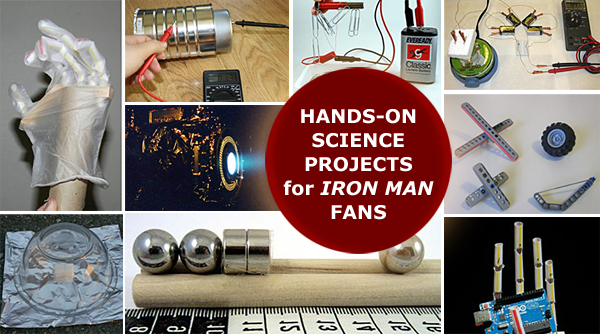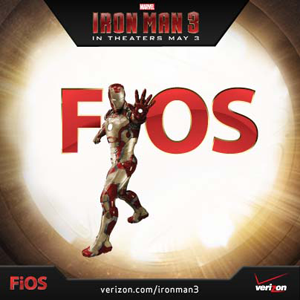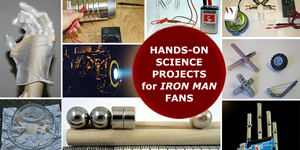Excitement About Iron Man Fuels Student Science Inquiry
With the third Iron Man movie coming to the big screen next week, now is a great time to spark science and engineering excitement among student fans.
With Marvel's Iron Man 3 hitting theaters on May 3, excitement among sci-fi fans is mounting. Whether you are a long-time follower of Iron Man or are just getting acquainted with Tony Stark and his series of high-tech, high-flying suits, the momentum of the coming release is palpable. If you are anxiously awaiting the next Iron Man movie installment, you can build on the anticipation by thinking through, talking about, and, even better, diving in and exploring some of the science at the heart of the movie. There is plenty of it!
The Iron Man storyline is steeped in science, which gives you and your older kids multiple science angles to consider as you wait for opening weekend. Tying science to pop culture is often a good way to get kids hooked and to inspire them to see the ways in which what they see and love on screen, in a game, or in a comic or book is connected to real-world principles of physics, engineering, technology, robotics, chemistry, biotechnology, and more. In other words, when science, technology, engineering, and math (STEM) are on screen, the stars might be all lined up to spark scientific inquiry of quantum proportions!
Note: The Iron Man movies are rated PG-13. Parents should use their own discretion to evaluate suitability of the movies for their children. Parents can learn more about suggested viewing at Common Sense Media.
Science: The Allure of Iron Man
My own kids were too young the first time around, so Iron Man and Iron Man 2 passed me by. But age aside, other than Professor X and his school for "gifted students" (AKA mutants), my kids have always been oddly and concertedly anti-superhero. Spiderman. Superman. Incredible Hulk. Green Lantern. Batman. None of these characters (all of which I grew up with) ever really grabbed their imagination. Astro Boy, maybe. But not the classic comic book super heroes, big screen or not.
With Iron Man 3 coming, I wanted to catch up on the movie storyline firsthand. We settled in to watch Iron Man and Iron Man 2, and we are hooked, palladium arc reactor, jet-propulsion system, head-up display, house AI system, and all.
We watched the movies out of order, and it wasn't far into Iron Man (which we saw second) that my oldest said, "I like Iron Man because the science is believable." Bingo! Having recently helped pull together some Iron Man-related Project Ideas from the deep library of hands-on science projects and activities at Science Buddies, his words seemed right on target.
While the science may not all be "real," translated to mean currently in use today, the science may be real "enough" to captivate budding engineers, technologists, physicists, and computer programmers. Real enough. Possible. Grounded. And that's just it, isn't it? Part of the appeal for much of the audience who responds to the things Tony Stark builds and to the way he talks about engineering, physics, the suit, and the arc reactor may be that Tony Stark makes science very, very cool. Plus, as he says in one of the Iron Man 3 trailers on the Marvel movie site, "I'm Tony Stark. I build neat stuff. I've got a great girl and, occasionally, save the world."
Tying Real Science to the Big Screen
Science Buddies knows that the secret to getting some students engaged with science is meeting them where they are and tying hands-on science exploration to an area of personal interest. For students who are into the world of Iron Man, there are plenty of angles to explore and plenty of room to experiment. Build a mini arc reactor for the science fair? Probably not. Land in the middle of the science fair in a jet powered mini Iron Man suit like in the clever Verizon FiOS video? Maybe not. But explore the kinds of engineering that go into designing a robot, from considerations about the anatomy (and what the robot needs to "do") to programming a robot using servo motors and Arduino—absolutely! You might not be able to build your own particle accelerator and create a new element. But building a cloud chamber and seeing evidence of radioactive particles flying through the air can open their eyes and clue students in to what's all around us. Or explore magnetic acceleration stages with a cool DIY gizmo like a Gauss rifle.
See our full list of science, technology, and engineering project tie-ins for Iron Man fans for suggestions to help you and your students delve deeper into the science at the core of the Iron Man saga.
Engineering Design Process in Action
Watching Iron Man, I was struck by the moment when Stark, a prisoner, shows Yinsen, another captive, a series of drawings on paper. Like a series of transparencies, when the schematics are stacked up and pressed together, Stark's vision for the first Iron Man suit comes together in one visible and awesome whole. From there, the movie—and the evolution of Iron Man—unfolds. That moment also highlights something important that underwrites the story—with every step he takes in developing "Iron Man," Stark puts the engineering design process in action.
Stark's development of the Iron Man suit's flight system is a great example of the engineering process. His initial flight system helps him escape, but it's a rudimentary system, and he crash lands. Back in his lab, with his assemblage of handy robots to help, Stark gets to work refining the system. He knows what he "needs," and he knows what went wrong with the first suit and the leg-mounted jets. He prototypes a new system with feet and hand repulsors. And then he tests. And he tests again. At each stage, there are refinements to make based on testing data. And with each set of refinements, he gets closer to his goal. When he gets over-eager and takes the suit for a real-world flight, he discovers another critical flaw in the design—the effects of extreme temperature. The need to safeguard against this weakness leads to the creation of a new suit using a different metal.
If we recast the scenes of the suit's creation and testing into the steps of the design process, we see the following stages:
- Define the Problem: needs the ability to fly
- Do Background Research: initial, ad hoc attempt led to crash-landing
- Specify Requirements: able to be integrated in a suit, balanced, controlled landing, etc.
- Build a Prototype: Stark builds a working model
- Test and Redesign: he tests in the lab, redesigns, and then tests again and again
Talking with students about the stages of the engineering design process, and the ways in which Stark enacts those stages, is a great way to help students understand the engineering process, the importance of testing, and the sometimes cyclical process of prototyping, testing, prototyping again, and retesting.
Exclusive Iron Man Video Trailer—Coming April 29!
Stay tuned on the Science Buddies Facebook page for information about an exclusive Iron Man 3 video trailer from Verizon FiOS. Watch the exclusive Iron Man 3 footage on April 29! For every view, Verizon FiOS will donate $0.01 to Science Buddies.
Categories:
You Might Also Enjoy These Related Posts:
- Star Wars Projects for May the 4th Be With You Science
- Mario Day STEM — Bring Mario World to Life with Hands-on Science and Engineering Activities!
- When Your Science Project Opens a Wormhole--Alternate Universe Movie for Science Class
- Science with Fidget Spinners
- Water on Mars—From Sci-Fi to Space Science
- A Dolphin Tail and Prosthetics Engineering
- LEGO Movie Makes Engineering Awesome
- Iron Man and Fiber Optics—Technology at the Speed of Light












